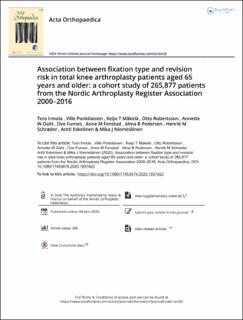| dc.contributor.author | Irmola, Tero | |
| dc.contributor.author | Ponkilainen, Ville | |
| dc.contributor.author | Mäkelä, Keijo | |
| dc.contributor.author | Robertsson, Otto | |
| dc.contributor.author | W-Dahl, Annette | |
| dc.contributor.author | Furnes, Ove | |
| dc.contributor.author | Fenstad, Anne Marie | |
| dc.contributor.author | Pedersen, Alma B. | |
| dc.contributor.author | Schrøder, Henrik M. | |
| dc.contributor.author | Eskelinen, Antti | |
| dc.contributor.author | Niemeläinen, Mika J | |
| dc.date.accessioned | 2021-05-05T11:10:03Z | |
| dc.date.available | 2021-05-05T11:10:03Z | |
| dc.date.created | 2020-11-22T14:10:13Z | |
| dc.date.issued | 2021 | |
| dc.Published | Acta Orthopaedica. 2020, 1-6. | |
| dc.identifier.issn | 1745-3674 | |
| dc.identifier.uri | https://hdl.handle.net/11250/2753666 | |
| dc.description.abstract | Background and purpose — The population of the Nordic countries is aging and the number of elderly patients undergoing total knee arthroplasty (TKA) is also expected to increase. Reliable fixation methods are essential to avoid revisions. We compared the survival of different TKA fixation concepts with cemented fixation as the gold standard.
Patients and methods — We used data from the Nordic Arthroplasty Register Association (NARA) database of 265,877 unconstrained TKAs performed for patients aged ≥ 65 years with primary knee osteoarthritis between 2000 and 2016. Kaplan–Meier (KM) survival analysis with 95% confidence intervals (CI) and the Cox multiple-regression model were used to compare the revision risk of the fixation methods.
Results — Cemented fixation was used in 243,166 cases, uncemented in 8,000, hybrid (uncemented femur with cemented tibia) in 14,248, and inverse hybrid (cemented femur with uncemented tibia) fixation in 463 cases. The 10-year KM survivorship (95% CI) of cemented TKAs was 96% (96 − 97), uncemented 94% (94 − 95), hybrid 96% (96 − 96), and inverse hybrid 96% (94 − 99), respectively. Uncemented TKA was associated with increased risk of revision compared with the cemented TKA; the adjusted hazard ratio was 1.3 (95% CI 1.1 − 1.4).
Interpretation — Cemented, hybrid, and inverse hybrid TKAs showed 10-year survival rates exceeding 95%. Uncemented fixation was associated with an increased risk of revision in comparison with cemented fixation. As both hybrid and inverse hybrid fixation were used in only a limited number of TKAs, indicating possibility of selection bias in their favor, cemented TKA still remains the gold standard, as it works reliably in the hands of many. | en_US |
| dc.language.iso | eng | en_US |
| dc.publisher | Taylor & Francis | en_US |
| dc.rights | Navngivelse 4.0 Internasjonal | * |
| dc.rights.uri | http://creativecommons.org/licenses/by/4.0/deed.no | * |
| dc.title | Association between fixation type and revision risk in total knee arthroplasty patients aged 65 years and older: a cohort study of 265,877 patients from the Nordic Arthroplasty Register Association 2000–2016 | en_US |
| dc.type | Journal article | en_US |
| dc.type | Peer reviewed | en_US |
| dc.description.version | publishedVersion | en_US |
| dc.rights.holder | Copyright 2020 The Authors | en_US |
| cristin.ispublished | true | |
| cristin.fulltext | original | |
| cristin.qualitycode | 1 | |
| dc.identifier.doi | 10.1080/17453674.2020.1837422 | |
| dc.identifier.cristin | 1850741 | |
| dc.source.journal | Acta Orthopaedica | en_US |
| dc.source.pagenumber | 91-96 | en_US |
| dc.identifier.citation | Acta Orthopaedica. 2021, 92(1): 91-96 | en_US |
| dc.source.volume | 92 | en_US |
| dc.source.issue | 1 | en_US |

